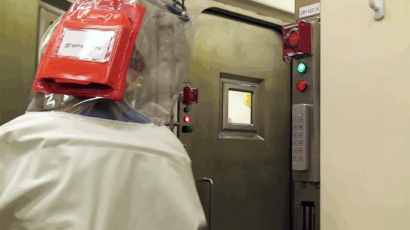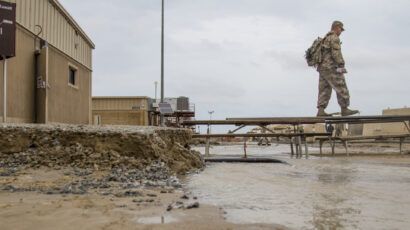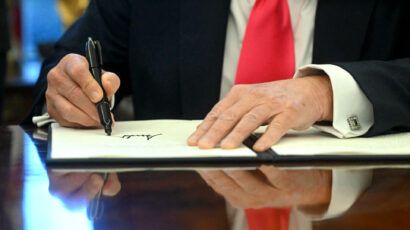Technical concerns: Why Russia worries about missile defense
By Ivanka Barzashka | May 14, 2012
Russia’s Ministry of Defense held an unprecedented international conference in Moscow last week to explain “how NATO missile defense facilities … may affect Russia’s forces of nuclear deterrence.” Senior Russian military officials used the meeting, which included 200 participants from 50 countries, to publicly back President Vladimir Putin’s decision to skip the NATO summit in Chicago later this month due to the impasse over US missile defense deployments in Europe, now the core of the NATO system. The NATO-Russia Council resolved to cooperate on missile defense during the 2010 Lisbon Summit.
The conference added little to Russia’s official, political position on missile defense. Moscow had already made very clear at least some of the reasons it worries about growing NATO capability and how it would counter advanced missile defenses if they are deployed. Washington denies the system threatens Russia. Independent US experts , however, haven’t been able to agree on whether Russian political statements have technical merit; they have had to make assumptions about what conservative Russian military planners are thinking. This has now changed. Last week, Russia’s Ministry of Defense explained the technical argument behind Moscow’s long-standing concerns. As yet, it is unclear how valid these technical assertions may be, but they could at least act as a concrete starting point for expert dialogue that could help Russia and NATO reach some kind of missile defense accommodation.
Offense-defense. The inextricable link between strategic defenses and offenses is at the core of Russian concerns over NATO deployments. On Russia’s insistence, the linkage was clearly stated in the preamble of the New START treaty. It has been cited by former President and current Prime Minister Dmitry Medvedev and was repeated last week by the Chief of the General Staff, Nikolay Makarov. But the connection isn’t a novel idea. Western Cold War strategists have long argued that the deployment of defenses by one side would reduce the effectiveness of the other side’s second-strike weapons. This would jeopardize mutual nuclear deterrence and create instability, causing an arms race or creating incentives for the first use of nuclear weapons during conflict — and this is exactly the language being used by Russia today. Moscow sees global security as “equal and indivisible” and dependent on the mutual nuclear deterrence relationship between it and the United States. This means Washington’s improvement of its security via missile defenses should not undercut Moscow’s security by reducing its confidence in its nuclear weapons arsenal.
Chief of Staff Makarov described European deployments as part of a US global missile defense system that, as a whole, threatens Russian nuclear strategic forces and outlined a series of retaliatory measures if “deployed BMD assets appear to be on the rise.” He warned that Russia may pre-emptively take out NATO missile defense sites in a “period of heightening tension” because the system might enable a US nuclear first strike. This classic example of crisis instability was reported as new by the New York Times and the Associated Press but was, in fact, simply an expansion on a list of possible Russian responses to NATO missile defenses that Medvedev gave in a November 2011 televised speech. Still, throughout the conference, Ministry of Defense officials stressed that Cold War thinking doesn’t have to prevail, and there is still time for cooperation.
Russian officials have expressed at least six general areas of technical concerns about the NATO missile defense system:
- Legal guarantees. As a pre-condition to any cooperation agreement, Moscow wants legally binding guarantees that missile defenses will not target Russia, seeing US withdrawal from the ABM Treaty in 2001 as “a mistake.” Senior US and NATO officials have repeated that the system is not aimed against Russia, but Moscow claims that changeable political winds make informal assurances worthless: “Good intentions come and go, while military capability is what stays,” Foreign Minister Sergey Lavrov said. Instead, President Medvedev has asked for a formal treaty outlining “specific military-technical criteria that will enable Russia to judge to what extent US and NATO action in the missile defence area correspond to their declarations and steps, whether [Russia’s] interests are being impinged on, and to what extent the strategic nuclear balance is still intact.” Last week, Makarov elaborated that these criteria would include the technical characteristics of missile defense components (such as interceptor numbers, speed, and radar range), their location, and their performance. This would allow for a joint understanding of NATO’s deployment plans and their impact on strategic stability. Thorough verification measures would ensure security. He did not specify whether Moscow wants to place limits on certain technical characteristics of the system or simply ensure NATO is acting according to plan, thus increasing stability by allowing more time for a Russian response.
- Uncertainty. NATO says its missile defense system is flexible and adaptive and deployments would correspond to the ballistic missile threat from the south. (Because of Turkish sensitivity, NATO cannot explicitly label Iran as the threat.) It is this adaptive uncertainty, not today’s capabilities, that most concerns Russia. US radars and satellites could be upgraded and integrated to work jointly with additional ally and partner sensors to seriously “beef up” the system’s efficiency, Deputy Chief of General Staff Colonel-General Vladimir Gerasimov said. Colonel Evgeny Ilyin added that the mobility of sea-based assets, the numbers of deployed interceptors, and their velocities were among the other factors that, if enhanced, could pose a threat to Russia. Moscow is unsure about the NATO system’s parameters but knows what they should not be.
- South, not north. Interceptor missiles deployed in northern Europe, either on the ground in Poland or on Aegis ships in the North Sea, could reach Russian nuclear missiles headed for the United States, according to Gerasimov. In 2011, Lieutenant-General Andrei Tretyak, who heads the General Staff’s Main Operations Directorate, explained: “Four hundred interceptor missiles on 40 warships and a missile site in Poland. This is a real threat to our strategic nuclear forces.” In a 2011 op-ed in the New York Times, Dimitry Rogozin, President Medvedev’s missile defense envoy, wrote that “Russia does not want US anti-missile defenses to extend to our territory, especially to its North European part, because should a negative scenario develop, this could upset the strategic balance of forces between our country and the United States.”
- Away from borders. Russian officials have expressed concerns about any deployments close to their borders because they could transform the missile shield into “something offensive that could control Russian territory as far as the Urals.” Gerasimov and Ilyin‘s briefings showed that shooters in Poland and off the Baltic coast could catch Russian missiles headed toward the US. Earlier, Lavrov also criticized the US radar deployed in Turkey because it duplicates an existing American radar that could track missiles originating in the Middle East and could “simultaneously scan a significant part of Russia.” However, the Ministry of Defense did not complain about the Turkish radar but did advertise the capabilities of its Gabala and Armavir radars — what would likely be Russia’s contribution to a joint system — to spot and track missile launches from the south. The Russian Ministry of Foreign Affairs was also unhappy about the participation of the USS Monterey — the first missile defense cruiser deployed as part of the European Phased Adaptive Approach — in anti-piracy military exercises in the Black Sea last summer. The Montreux Convention restricts access of US warships to the Black Sea. Because missile interceptors would have no role in fighting pirates, Moscow saw the multi-purpose ship’s presence in this “highly sensitive region” as a reconnaissance mission. However, no Black Sea scenarios were discussed at the meeting in Moscow, and neither were any NATO-Russia conflicts using conventional weapons.
- Slower shooters. Russian military planners consider the deployment of faster SM-3 Block II A/B interceptors during Phase 3 and 4 of the European Phased Adaptive Approach as most problematic. Simulations presented by Gerasimov showed that Russian intercontinental ballistic missiles could be intercepted by faster shooters fielded in Poland and even Romania. The burnout velocities of SM-3 Block II variants have not been made public, but Ilyin explained that exceeding a velocity of 5 kilometers per second “creates a real threat to the Russian deterrence capability”; this is due to the launch geometry of missiles and interceptors and the much faster speed of intercontinental ballistic missiles. Medvedev warned that the Phase 4 fast-interceptor deployments will mark a turning point: “If we do not reach agreement by 2020, a new arms race will begin.”
- Match the threat. NATO and Russia approved a joint threat assessment in 2010, and a bilateral assessment between Moscow and Washington was concluded the following year, but Russia now wants objective criteria “that would allow for assessing whether the missile defense system squares with its stated aim.” According to Russian military intelligence, “south-east nations” do not have longer-range missiles and have no incentives to initiate an attack on Europe with the shorter range missiles they have, as Major General Sergun, who heads the Main Intelligence Directorate of the General Staff, explained. Putin declared that because “neither Iran nor North Korea poses a threat… Today, it’s missile defense that is certainly aimed at neutralizing Russia’s nuclear missile potential.” Sergun concluded that missile proliferation should be first addressed through preventive diplomacy, strengthening existing arms control and nonproliferation regimes, not through “building expensive BMD assets that are not always adequate to existing missile threats.” Earlier, the Russian Ministry of Foreign Affairs explained that negotiations and sanctions could prevent “challenges from developing into real missile threats” but that a joint military-technical response was possible if “real threats” did develop.
Fait accompli. In Chicago, NATO will announce that its missile defense system has achieved an interim capability — integrating US European Phased Adaptive Approach Phase 1 assets with NATO command and control. Though the alliance says it remains open to cooperation with Russia, it is forging ahead with deployments. Moscow sees these advancements as a sign that NATO is not sincere about cooperation and Russia is being presented with a “fait accompli.” President Putin was more direct: “It seems to me that our partners are looking for vassals, not allies. They want to govern. But Russia cannot come into line with this.”
The Moscow conference provides valuable insights into Russian military planning and is, perhaps, the start of the “constructive and unbiased dialogue with scholars and experts” that Medvedev advocated in a March speech at the Russian Council for International Affairs. The NATO-Russia missile defense standoff appears to be a narrow technical issue, but it is fueled by broader political concerns. Untangling Russian technical and political concerns is key to finding a way forward. If Moscow’s objections are entirely political, then giving Russia a seat at the table might be enough; some cooperation measures could be worth pursuing for purely political reasons. It is unlikely, however, that a missile defense option with no technical merit — that is, one that is simply symbolic — would be politically adequate. Some of Moscow’s objections to NATO’s current missile defense plans could be technically valid, making political guarantees alone inadequate and perhaps justifying hardware decisions that could help turn a missile defense crisis into a missile defense agreement.
Editor’s note: The author thanks Ivan Oelrich and Evgeny Buzhinsky for their insightful comments and Frank Hemmes for his discussion and research on the topic.
Together, we make the world safer.
The Bulletin elevates expert voices above the noise. But as an independent nonprofit organization, our operations depend on the support of readers like you. Help us continue to deliver quality journalism that holds leaders accountable. Your support of our work at any level is important. In return, we promise our coverage will be understandable, influential, vigilant, solution-oriented, and fair-minded. Together we can make a difference.
Topics: Missile Defense, Nuclear Weapons, Opinion















